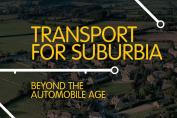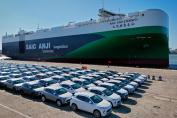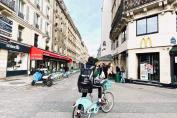Contact
- For any questions regarding a Forum research project, please contact the project manager whose name is indicated on the page (see the “Project” section)
- For any questions regarding an event, one of our books or the valuation of a project, please contact Tom Dubois
- For press relations please, contact Véronique Wasa or consult our Press page
- To add an event to the calendar, please contact Thomas Evariste
- To submit a new book for the section "New in the library", please contact Thomas Evariste.
- For any other questions, please contact Sylvie Landriève

 Subscribe to the newsletter
Subscribe to the newsletter



































 Bicycle storage area at Houten train station, Netherlands. Credit: Martin Bond / Alamy
Bicycle storage area at Houten train station, Netherlands. Credit: Martin Bond / Alamy
 Amsterdam has a reputation as a bicycle-friendly city. Credit: Charlie Red
Amsterdam has a reputation as a bicycle-friendly city. Credit: Charlie Red
 More than a third of daily journeys in Amsterdam are done by bicycle. Credit: Peyman Shojaei
Cycling is perceived to be so intrinsic to Dutch identity that the Dutch Cycling Culture has been nominated for a place on the national list of UNESCO intangible heritage. The modal share of cycling has been more or less stable for the last three decades at around 28% of all trips, covering 10% of all national km travelled and 21% of travel time. Measured by kilometres travelled, bicycle use has increased by some 12% since 2005 (this is explained by growth in the number of cyclists and growth in mobility per capita).
More than a third of daily journeys in Amsterdam are done by bicycle. Credit: Peyman Shojaei
Cycling is perceived to be so intrinsic to Dutch identity that the Dutch Cycling Culture has been nominated for a place on the national list of UNESCO intangible heritage. The modal share of cycling has been more or less stable for the last three decades at around 28% of all trips, covering 10% of all national km travelled and 21% of travel time. Measured by kilometres travelled, bicycle use has increased by some 12% since 2005 (this is explained by growth in the number of cyclists and growth in mobility per capita).
 Almost half of the total distance travelled by conventional bicycles in the Netherlands is for leisure purposes. Credit: Jian Liu.
Such high levels of cycling are facilitated by the most well-developed cycling network in Europe, stretching over 35,000 km of cycling paths physically segregated from motor traffic which is equal to a quarter of the country's entire 140,000 km road network. In addition to this, around 70% of Dutch urban streets have a speed limit of 30 km/h.[^5]
Almost half of the total distance travelled by conventional bicycles in the Netherlands is for leisure purposes. Credit: Jian Liu.
Such high levels of cycling are facilitated by the most well-developed cycling network in Europe, stretching over 35,000 km of cycling paths physically segregated from motor traffic which is equal to a quarter of the country's entire 140,000 km road network. In addition to this, around 70% of Dutch urban streets have a speed limit of 30 km/h.[^5]
 Segregated cycling path (pink) and bicycle parking in Alkmaar, Netherlands. Credit: Marek Lumi.
Segregated cycling path (pink) and bicycle parking in Alkmaar, Netherlands. Credit: Marek Lumi.
 Segregated cycling paths (pink) near a roundabout. Credit: Ezra
Segregated cycling paths (pink) near a roundabout. Credit: Ezra
 A 220 metre long bike path and footbridge over a highway and railway track, part of a cycle network in the future nature reserve New Driemanspolder in Zoetermeer. Credit: Jochen Tack / Alamy
As for the railway network, there are over 400 train stations, the track length is 7,000 km, and since 2017 all trains have been powered by wind-generated electricity. With around 1.5 million travellers daily it is the busiest railway network in Europe[^6] and more than one in ten of all trips of more than 15 km are train trips.
Of all train journeys 83% are multimodal trips and within this share the combination of bicycle–train for access to the station represents around 47% of all train passengers (up to 70% in certain stations). The key aspect of this outstanding figure is that it continues to grow (up from 30% in 2001)[^7], reflecting similar trends in the overall number of bicycle and train trips in and between Dutch cities. Bicycle trips from the station to the final destination have also increased from 10% to 16%, a development partly related to the introduction of rental bicycles for train season-ticket holders.[^8] During this period train trips have increased by 36%. This means an increase in the absolute number of bike-train trips.
A 220 metre long bike path and footbridge over a highway and railway track, part of a cycle network in the future nature reserve New Driemanspolder in Zoetermeer. Credit: Jochen Tack / Alamy
As for the railway network, there are over 400 train stations, the track length is 7,000 km, and since 2017 all trains have been powered by wind-generated electricity. With around 1.5 million travellers daily it is the busiest railway network in Europe[^6] and more than one in ten of all trips of more than 15 km are train trips.
Of all train journeys 83% are multimodal trips and within this share the combination of bicycle–train for access to the station represents around 47% of all train passengers (up to 70% in certain stations). The key aspect of this outstanding figure is that it continues to grow (up from 30% in 2001)[^7], reflecting similar trends in the overall number of bicycle and train trips in and between Dutch cities. Bicycle trips from the station to the final destination have also increased from 10% to 16%, a development partly related to the introduction of rental bicycles for train season-ticket holders.[^8] During this period train trips have increased by 36%. This means an increase in the absolute number of bike-train trips.
 Amsterdam Central Train Station. Credit: Marek Slusarczyk / Alamy
Scope for further growth is also found in the high density of a predominantly urban population[^9]. This is especially the case around the Randstad area (which includes the cities of Amsterdam, Rotterdam, Utretch, The Hague, Haarlem, Hilversum, Dordrecht and Leiden)[^10] which is the most densely populated area of the Netherlands, a country which is one of the most densely populated in the world. In this area the total trips made by cycling and by transit have surpassed the number of trips made by car. Randstad has an established cycling culture and a quality train network, with a service frequency of up to 10 min between main cities. In addition, this area is characterised by large commuter flows between its main cities and surrounding areas which also increases the potential appeal of bike–train travel. Travel time from the centre of Arnhem to the Rijksmuseum in Amsterdam (approx 100 km) is the same for both the bike/train combination and the car (around 1hour 15 minutes). Travelling from Utretch to Amsterdam (approx 40 km) is now also as fast by bike/train as it is by car (40 minutes).
Amsterdam Central Train Station. Credit: Marek Slusarczyk / Alamy
Scope for further growth is also found in the high density of a predominantly urban population[^9]. This is especially the case around the Randstad area (which includes the cities of Amsterdam, Rotterdam, Utretch, The Hague, Haarlem, Hilversum, Dordrecht and Leiden)[^10] which is the most densely populated area of the Netherlands, a country which is one of the most densely populated in the world. In this area the total trips made by cycling and by transit have surpassed the number of trips made by car. Randstad has an established cycling culture and a quality train network, with a service frequency of up to 10 min between main cities. In addition, this area is characterised by large commuter flows between its main cities and surrounding areas which also increases the potential appeal of bike–train travel. Travel time from the centre of Arnhem to the Rijksmuseum in Amsterdam (approx 100 km) is the same for both the bike/train combination and the car (around 1hour 15 minutes). Travelling from Utretch to Amsterdam (approx 40 km) is now also as fast by bike/train as it is by car (40 minutes).
 Rental bicycles at Veenendaal-De Klomp railway station. Credit: Fantaglobe11 CC BY-SA 4.0
Despite the remarkable growth, demand for rental bikes still outstrips current supply. This explains (at least in part) why, even though the percentage of trips made to the station by bicycle continues to grow (from 33% to 47% in the period 2013-2016) the percentage of egress trips made by bicycle remains constant. The provision of rental bikes is seen as a necessary step to increase train travel.[^12]
Rental bicycles at Veenendaal-De Klomp railway station. Credit: Fantaglobe11 CC BY-SA 4.0
Despite the remarkable growth, demand for rental bikes still outstrips current supply. This explains (at least in part) why, even though the percentage of trips made to the station by bicycle continues to grow (from 33% to 47% in the period 2013-2016) the percentage of egress trips made by bicycle remains constant. The provision of rental bikes is seen as a necessary step to increase train travel.[^12]
 Entrance to the Rotterdam Central Station, Rotterdam, Netherlands, 2016. Credit: Jurria An
Progress is being made in this direction. Improving connections at the first and last mile has been a priority since at least the 1990s and this has included active efforts to increase the quality and quantity of bicycle parking. From 1999 to 2012 the investment programme ‘space for the bicycle’ sought to make available 400,000 new bicycle parking spaces by 2012 and in the last ten years more than € 221 million was invested as part of the Action Plan for Bicycle Parking at Stations to create an additional 100,000 spaces. A further € 200 million was allocated in 2020 to create 100,000 more new parking spaces by 2025.
Entrance to the Rotterdam Central Station, Rotterdam, Netherlands, 2016. Credit: Jurria An
Progress is being made in this direction. Improving connections at the first and last mile has been a priority since at least the 1990s and this has included active efforts to increase the quality and quantity of bicycle parking. From 1999 to 2012 the investment programme ‘space for the bicycle’ sought to make available 400,000 new bicycle parking spaces by 2012 and in the last ten years more than € 221 million was invested as part of the Action Plan for Bicycle Parking at Stations to create an additional 100,000 spaces. A further € 200 million was allocated in 2020 to create 100,000 more new parking spaces by 2025.
 Bicycle parking under solar panels at Wijchen train station. Credit: Fantaglobe11 CC BY-SA 4.0
Now in 2023 every station in the Netherlands has one or more bicycle parking facility (either at street level, indoor or underground), 106 of which offer secure parking garages, with half of these operated automatically and half staffed by attendants. More than 30 stations now offer on-site repair shops. These developments are encouraging but insufficient as the number of train travellers arriving to the station by bicycle continues to outpace the creation of new bicycle parking spaces.
Bicycle parking under solar panels at Wijchen train station. Credit: Fantaglobe11 CC BY-SA 4.0
Now in 2023 every station in the Netherlands has one or more bicycle parking facility (either at street level, indoor or underground), 106 of which offer secure parking garages, with half of these operated automatically and half staffed by attendants. More than 30 stations now offer on-site repair shops. These developments are encouraging but insufficient as the number of train travellers arriving to the station by bicycle continues to outpace the creation of new bicycle parking spaces.
 Parking facilities at Utretch Central Station. Credit: Jochen Tack / Alamy
Access to the garage is by bike and parking is free for the first 24 hours. Beyond that Dutch Railways charges € 1.35 per day (the fee is € 0.55-0.65 per day at garages that operate automatically). The facilities are open 24/7 and cyclists check in and out with their public-transport chip card. The upper and lower floors are for bicycles parked during the day and the middle floor is reserved for bicycles owned by parking card holders (residents can buy a bike storage pass for € 80 a year). In addition to the 12500 parking spaces there are also 1000 OV-Fiets.
Parking facilities at Utretch Central Station. Credit: Jochen Tack / Alamy
Access to the garage is by bike and parking is free for the first 24 hours. Beyond that Dutch Railways charges € 1.35 per day (the fee is € 0.55-0.65 per day at garages that operate automatically). The facilities are open 24/7 and cyclists check in and out with their public-transport chip card. The upper and lower floors are for bicycles parked during the day and the middle floor is reserved for bicycles owned by parking card holders (residents can buy a bike storage pass for € 80 a year). In addition to the 12500 parking spaces there are also 1000 OV-Fiets.
 The bicycle garage in Utrecht train station includes repair services. Credit: Jochen Tack / Alamy
The garage includes a special area for bicycles with different shapes (e.g. cargo, ‘mummy/daddy-bicycle’) and offers a service point for repairs, maintenance, parts and accessories. Forty people are employed at the facility and wardens ensure that bicycles are correctly parked. They also remove bicycles that have not been used after 28 days. If a bicycle is stolen the owner is entitled to a reimbursement of € 750. This new garage with its 12,500 spaces is part of a set of parking facilities around Utretch Central Station totalling around 33,000 bicycle parking spaces.
The bicycle garage in Utrecht train station includes repair services. Credit: Jochen Tack / Alamy
The garage includes a special area for bicycles with different shapes (e.g. cargo, ‘mummy/daddy-bicycle’) and offers a service point for repairs, maintenance, parts and accessories. Forty people are employed at the facility and wardens ensure that bicycles are correctly parked. They also remove bicycles that have not been used after 28 days. If a bicycle is stolen the owner is entitled to a reimbursement of € 750. This new garage with its 12,500 spaces is part of a set of parking facilities around Utretch Central Station totalling around 33,000 bicycle parking spaces.
 Credit: Jochen Tack / Alamy
Credit: Jochen Tack / Alamy
 Member of staff at the bicycle garage. Credit: Ton Koene / Alamy
Map of the facility:
Member of staff at the bicycle garage. Credit: Ton Koene / Alamy
Map of the facility:  Outdoor bicycle storage space, Amsterdam. Credit: Alice
The building of bicycle parking stations is also partly related to the desire to maintain train station squares and their surroundings as attractive public spaces. Busy stations with limited parking facilities faced the problem of large numbers of bicycles being left in unsecured parking spaces outside the station and randomly parked bicycles in the vicinity. Meanwhile monitored parking often remained underused. The Dutch railway operator addressed this issue by making parking in monitored areas free for the first 24 hours. After the first 24 hours a small amount of money is taken from personal public transportation card. This new arrangement has made parking more efficient, increased occupancy and helped to deal with abandoned bicycles.[^13] Although this measure and the building of new parking facilities have been well received by users, cycling campaigners have criticised the fact that new parking stations are often accompanied by a no-tolerance policy towards on-street parking.
Outdoor bicycle storage space, Amsterdam. Credit: Alice
The building of bicycle parking stations is also partly related to the desire to maintain train station squares and their surroundings as attractive public spaces. Busy stations with limited parking facilities faced the problem of large numbers of bicycles being left in unsecured parking spaces outside the station and randomly parked bicycles in the vicinity. Meanwhile monitored parking often remained underused. The Dutch railway operator addressed this issue by making parking in monitored areas free for the first 24 hours. After the first 24 hours a small amount of money is taken from personal public transportation card. This new arrangement has made parking more efficient, increased occupancy and helped to deal with abandoned bicycles.[^13] Although this measure and the building of new parking facilities have been well received by users, cycling campaigners have criticised the fact that new parking stations are often accompanied by a no-tolerance policy towards on-street parking.
 Researchers suggest that bicycle-train travel is reshaping urban spatial dynamics. Credit: Smiley Toerist
The redrawing of the boundaries of catchment areas is an interesting process because only around 20% of the Dutch population lives within a 1 km walking distance of the 400 stations in the national system. This rises to around 70% and 80% for a cycling distance of 5 km and 7.5 km. Regarding intercity travel, only 1.1% of the Dutch population lives within a 1 km radius of the 17 main intercity stations, compared to 16-24% living within cycling distance.
Acceptable walking time to transit stops varies depending on the attributes of each station and the services available there (from 500 m for local bus stops to 2.2 km for an intercity station). Acceptable cycling distances can vary between 1.5 km to a local station and 7 km to an intercity station. This means that cycling increases particularly the catchment area of stations higher in the railway network hierarchy. Faster modes have wider catchment areas.
Researchers suggest that bicycle-train travel is reshaping urban spatial dynamics. Credit: Smiley Toerist
The redrawing of the boundaries of catchment areas is an interesting process because only around 20% of the Dutch population lives within a 1 km walking distance of the 400 stations in the national system. This rises to around 70% and 80% for a cycling distance of 5 km and 7.5 km. Regarding intercity travel, only 1.1% of the Dutch population lives within a 1 km radius of the 17 main intercity stations, compared to 16-24% living within cycling distance.
Acceptable walking time to transit stops varies depending on the attributes of each station and the services available there (from 500 m for local bus stops to 2.2 km for an intercity station). Acceptable cycling distances can vary between 1.5 km to a local station and 7 km to an intercity station. This means that cycling increases particularly the catchment area of stations higher in the railway network hierarchy. Faster modes have wider catchment areas.
 Students at the bicycle parking space at Delft train station. Credit: Fer Troulik
Importantly, researchers have found that people who know bicycle train travellers are more likely to emulate this behaviour. This important insight suggests the possibility that as more people embrace this mode of travel the increase in demand will grow in a non-linear way and this has implications, for example, for planning new parking facilities based on higher-than-current growth rates.
Students at the bicycle parking space at Delft train station. Credit: Fer Troulik
Importantly, researchers have found that people who know bicycle train travellers are more likely to emulate this behaviour. This important insight suggests the possibility that as more people embrace this mode of travel the increase in demand will grow in a non-linear way and this has implications, for example, for planning new parking facilities based on higher-than-current growth rates.
 Map showing existing (green), under construction by 2030 (orange) and projected but as yet not funded (brown) fast cycling routes in the Netherlands. The circles show the radius of distances deemed to be feasible by conventional and electric bicycles: 7.5 km (light) and 15 km (dark). Tour de Force 2020
One of its six key themes[^15] is the encouragement of multimodality and more specifically the bicycle-train travel combination. The provision of more and better bicycle parking at train stations in order to meet the expected increase in demand is a key priority and in 2020 the government allocated an additional 200 million euros to create another 100,000 parking spaces by 2025. In the Tour de Force Programme the Dutch Government sees itself as a networking partner, facilitating collaborations, commissioning research, amending regulations and co-funding projects.
These programmes mainly concern the provisioning of parking spaces and, in general, are regarded as having had a positive outcome. These schemes have helped to create around 100,000 bicycle parking spaces at train stations, bringing the country’s total to around half a million. These programmes are also seen as having improved the dialogue between government, rail companies, municipalities, regions and civil society actors. However, other elements of the integration of cycling and train travel such as the planning of new stations, changes to timetables and major new cycling routes have remained largely uncoordinated.
To sum up, in the past 20 years the number of people cycling to train stations has increased significantly and actions to facilitate parking have resulted in many large indoor and underground bicycle parking facilities at train stations. It has partially succeeded in reducing the anticipated deficit in bicycle parking spaces, especially at smaller stations. The introduction of a successful bicycle rental programme has also been a positive development. However, there has been only limited progress in information integration (cycling inclusive travel planners from door to door being either lacking or under-developed), and pricing arrangements to combine cycling and trains are virtually non-existent.
Map showing existing (green), under construction by 2030 (orange) and projected but as yet not funded (brown) fast cycling routes in the Netherlands. The circles show the radius of distances deemed to be feasible by conventional and electric bicycles: 7.5 km (light) and 15 km (dark). Tour de Force 2020
One of its six key themes[^15] is the encouragement of multimodality and more specifically the bicycle-train travel combination. The provision of more and better bicycle parking at train stations in order to meet the expected increase in demand is a key priority and in 2020 the government allocated an additional 200 million euros to create another 100,000 parking spaces by 2025. In the Tour de Force Programme the Dutch Government sees itself as a networking partner, facilitating collaborations, commissioning research, amending regulations and co-funding projects.
These programmes mainly concern the provisioning of parking spaces and, in general, are regarded as having had a positive outcome. These schemes have helped to create around 100,000 bicycle parking spaces at train stations, bringing the country’s total to around half a million. These programmes are also seen as having improved the dialogue between government, rail companies, municipalities, regions and civil society actors. However, other elements of the integration of cycling and train travel such as the planning of new stations, changes to timetables and major new cycling routes have remained largely uncoordinated.
To sum up, in the past 20 years the number of people cycling to train stations has increased significantly and actions to facilitate parking have resulted in many large indoor and underground bicycle parking facilities at train stations. It has partially succeeded in reducing the anticipated deficit in bicycle parking spaces, especially at smaller stations. The introduction of a successful bicycle rental programme has also been a positive development. However, there has been only limited progress in information integration (cycling inclusive travel planners from door to door being either lacking or under-developed), and pricing arrangements to combine cycling and trains are virtually non-existent.




